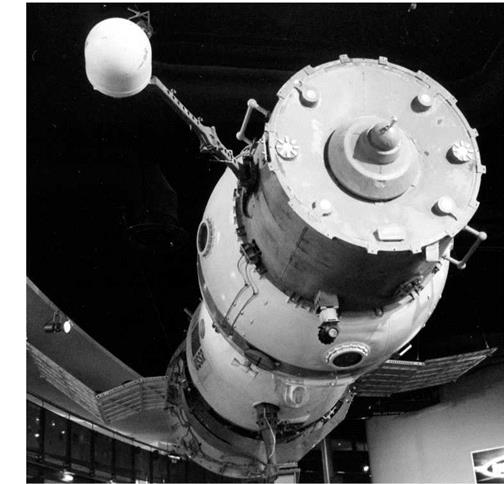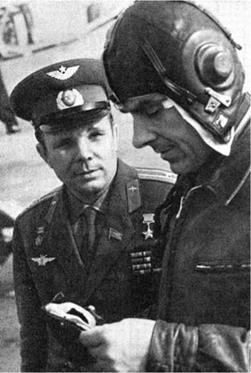ZOND’S ANCESTOR: SOYUZ
The basic Soyuz was 7.13 m long, 2.72m wide, with a habitable volume of 10.5m3, a launch weight of up to 6,800 kg, and a descent capsule weight of 2,800 kg. Soyuz consisted of three modules: equipment, descent and orbital. The equipment module contained retrorockets and manoeuvring engines, fuel, solar wings and supplies. The acorn-shaped descent module was the home of cosmonauts during ascent and descent, which one entered through the top. There were portholes, a parachute section and three contour seats. The orbital module, attached on the front, was almost circular, with a spacewalk hatch, lockers for food, equipment and experiments. Being more spacious, the cosmonauts lived there rather than the cramped descent module. From Soyuz there protruded a periscope for dockings, two seagull-like solar panels, aerials, docking probe on the front and flashing lights and beacons. On top of the Soyuz was an escape tower. Normally jettisoned at 2 min 40 sec into the flight, the purpose of the escape tower was to fire the Soyuz free of a rogue rocket. A solid rocket motor, with twelve angled nozzles of 80,000 kg thrust, would fire for 5 sec.
|
The Soyuz spacecraft |
The initial tests of Soyuz were not auspicious. The first test of Soyuz was Cosmos 133 on 28th November 1966. Cosmos 133 was to have docked with a second Soyuz, launched a day later, but this launch was cancelled when Cosmos 133 developed attitude control problems. The Cosmos could not be positioned properly for reentry and was destroyed deliberately for fear that it would land in China. During the second test, a month later, the rocket failed to take off. When the gantries were swung back around the rocket, the cabin was accidentally tipped, causing the escape tower to fire, thus setting the upper stage on fire and causing an explosion which destroyed the pad. One person died, but it could have been many more. The third test, Cosmos 140 on 7th February 1967, followed the test profile up to reentry when a maintenance plug in the heatshield burned through and caused structural damage. Worse followed: the cabin came down in the Aral Sea, crashed through ice and sank (divers later retrieved the cabin from 10 m down).
Despite these difficulties, Russia pressed ahead with a first manned flight of the Soyuz for April 1967. Instead of a cautious, single mission, a big shot was planned. Soyuz would go first, with a single cosmonaut on board, Vladimir Komarov. Twenty – four hours into the flight, Soyuz 2 would follow, commanded by veteran, Valeri Bykovsky. Two newcomers, Yevgeni Khrunov and Alexei Yeliseyev would fly with him. The rendezvous would simulate the moon link-up. Soyuz would be the active craft and would rendezvous on orbit 1. Then the show would really begin. Khrunov and Yeliseyev would don suits, leave Soyuz 2 and transfer into Soyuz to join Komarov. The spacewalk would simulate the transfer of cosmonauts between the the lunar orbiter and lunar lander as they circled the moon. The two ships would then separate after about four hours. Komarov, now accompanied by Khrunov and Yeliseyev, would be back on the ground by the end of day 2, Bykovsky following on day 3. So, in 72 breathtaking hours, the new Soyuz craft would demonstrate Earth orbit rendezvous on the first orbit, transfer by spacewalking to a primitive space station, carry out key tests for the moon flight and put the USSR back in front.
As the launch date drew near, there were a record 203 faults in Soyuz which required correction. The pre-test flights had been disconcerting. An atmosphere of foreboding prevailed at the cosmodrome. As Vladimir Komarov climbed into the transfer van to take the ride down to the pad, he had an air of fatalistic resignation about him. His fellow cosmonauts joshed him, trying to cheer him and get a smile. They started singing, encouraging him to join in. By the time they reached the pad some minutes later, he was singing with them too and the mood of pessimism had lifted somewhat. At 3: 35 a. m. Moscow time (not quite sunrise local time) on 23rd April 1967, the R-7 rocket lit the sky up and headed off in the direction of the growing embers of the onrushing dawn. Eight minutes later Vladimir Komarov was back in orbit testing out the most sophisticated spacecraft ever launched.
The trouble started at once when one of Soyuz’s two solar panels failed to deploy, starving the craft of electrical power. Other glitches developed as the day went on. The first attempt to change the craft’s orbit was unsatisfactory. The ship began to rotate around its axis and only spun more when Komarov tried to correct the problem. The thermal control system degenerated, communications with the ground became irregular and lack of electricity prevented the astro-orientation system from operating. The ion system had to be used instead. Ground control was considering a way of launching Soyuz 2 and for the spacewalking cosmonauts to free the errant solar panel of Soyuz when a tremendous storm hit the launch site and knocked out the electrical systems of the waiting rocket. The decision was taken to abandon the Soyuz 2 launch and bring Komarov home at the first available opportunity, on orbit 16 the next morning.
Even then, there was more trouble. Just as the attitude control system was lining up the Soyuz for reentry, the craft passed into darkness and it lost orientation. The decision was made to try again on orbit 17, even though it too would bring Soyuz far away from the normal landing site. Using procedures that he had never practised in training, Komarov managed to align the craft and fire the retrorockets himself. Despite his heroic efforts to save the mission, worse was to come. As the cabin descended through the atmosphere, the drogue parachute came out but the main parachute remained stubbornly in its container. When the reserve chute was popped out, it tangled in the lines of the drag chute of the main parachute. Soyuz 1 crashed at great speed into the steppe at Orenberg at 7 a. m. The cabin exploded on impact and when Air Force recovery teams arrived all they found was burning metal, the rim of the top of Soyuz being the only hardware they could identify. They piled on soil to extinguish the flames.
The control centre knew nothing of what had happened. As they closed in on the wreckage, the recovery team sent a garbled message to the effect that the cosmonaut needed ‘urgent medical attention’ (a euphemism for the worst possible news), but the local Air Force commander closed off all communications. Defence Minister Ustinov was informed of the true outcome at 11 a. m. and Leonid Brezhnev an hour later in Karlovy Vary, Czechoslovakia. The Soviet people were officially informed later in the day. Gagarin himself removed Komarov’s body from the wreckage. Some days later, some young Pioneers (boy scouts) found some further remains of Vladimir Komarov on the steppe. They buried them and made a small memorial for him of their own.
|
Soyuz spacecraft rendezvous, docking system |
Vladimir Komarov’s loyal comrades laid his remains to rest in the Kremlin Wall two days later. It was a sombre and chilling occasion, an unwelcome reminder of the real costs of the moon race. As the bands played the haunting Chopin funeral march the grim-faced and tight-lipped cosmonaut corps, now diminished to nine men and one woman, swore that the programme must go on relentlessly.
The consensus afterwards was that the whole mission had been rushed before Soyuz was really ready. It was apparent that Komarov had behaved masterfully in steering Soyuz successfully through reentry against all the odds. The failure in the parachute system was quite unrelated to the many problems that had arisen in the flight up to that time. The system for sealing the parachute container was defective, making the parachute likely to stick as it came out. This left the investigators with the chilling conclusion that if Soyuz 2 had been successfully launched, it too would have
|
Vladimir Komarov and his friend Yuri Gagarin |
crashed on its return. Years later, Valeri Bykovsky recalled how the storm had saved his life.
Early tests of Soyuz
28 Nov 1966 Cosmos 133 (failure)
Dec. 1966 Pad explosion
7 Feb 1967 Cosmos 140 (failure)
23 Apr 1967 Soyuz (failure)













